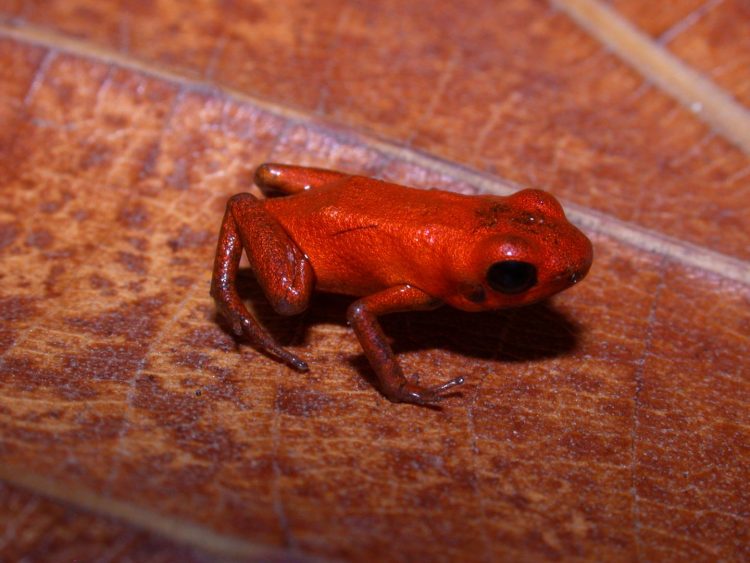Scientists discover new poison dart frog species in Donoso, Panama

The hololotype specimen, which scientists used as the basis to describe a new species of poison dart frog: Andinobates geminisae. Credit: Cesar Jaramillo, STRI
Every new species name is based on a representative specimen. The specimen for this species was collected Feb. 21, 2011, in the headwaters of the Rio Caño, in the district of Donoso, Colón Province, Panama, by Samuel Valdés, who was then the MWH Global Inc. environment office director, and his field assistant, Carlos de la Cruz. Additional specimens were collected between the Rio Coclé del Norte and the Rio Belen by biologists Marcos Ponce and Abel Batista, then a student at the Universidad Autónoma de Chiriquí.
The specimens were deposited in the Museo de Vertebrados at the University of Panama, the Museo Herpetólogico de Chiriquí at the Universidad Autónoma de Chiriquí and in the Círculo Herpetólogico de Panamá.
“Abel Batista and Marcos Ponce were the first to note the presence of this species,” said Cesar Jaramillo, Smithsonian herpetologist. “They've known it was there for several years. However, they were not sure if it was only a variety of another poison dart frog species, Oophaga pumilio, which exhibits tremendous color variation. Based on morphological characteristics of the adult and the tadpole, I thought it might be a new species of Andinobates.”
Andrew Crawford, professor at Universidad de Los Andes and former STRI postdoctoral fellow, sequenced the DNA, confirming that this was a new species of Andinobates. Genetic information about this species is available in the Barcode of Life Data System and in GenBank. A recording of the call is available at AmphibiaWeb.org.
Because this new frog species appears to be found in only a very small area, habitat loss and collecting for the pet trade are major threats to its existence. The authors recommend the formulation of special conservation plans to guarantee its survival. A. geminisae is included in the captive breeding program of the Panama Amphibian Rescue and Conservation project, a consortium of six zoos and research institutions dedicated to saving amphibians from the chytrid fungal disease, which is decimating amphibians worldwide, and habitat loss.
All collecting and export were done with permission from Panama's Environmental Authority, ANAM. Financial support for this study came from MWH Global Inc. and Minera Panama. Funding for DNA sequencing was provided by a CBOL grant to barcode the vertebrates of Panama.
For more information about amphibian biodiversity in Panama, visit amphibianrescue.org or the Smithsonian's new exhibit, Las Fabulosas Ranas de Panama, at Culebra Point Nature Center on Amador Causeway in Panama City.
The Smithsonian Tropical Research Institute, headquartered in Panama City, Panama, is a unit of the Smithsonian Institution. The Institute furthers the understanding of tropical nature and its importance to human welfare, trains students to conduct research in the tropics and promotes conservation by increasing public awareness of the beauty and importance of tropical ecosystems. Website: http://www.stri.si.edu. Promo video: https://www.youtube.com/watch?v=M9JDSIwBegk
Batista, A., Jaramillo, C.A., Ponce, M., Crawford, A. 2014 A new species of Andinobates (Amphibia:Dendrobatidae) from west central Panama. Zootaxa 3:333-352 http://dx.doi.org/10.11646/zootaxa.3866.3.2
Media Contact
All latest news from the category: Life Sciences and Chemistry
Articles and reports from the Life Sciences and chemistry area deal with applied and basic research into modern biology, chemistry and human medicine.
Valuable information can be found on a range of life sciences fields including bacteriology, biochemistry, bionics, bioinformatics, biophysics, biotechnology, genetics, geobotany, human biology, marine biology, microbiology, molecular biology, cellular biology, zoology, bioinorganic chemistry, microchemistry and environmental chemistry.
Newest articles

Properties of new materials for microchips
… can now be measured well. Reseachers of Delft University of Technology demonstrated measuring performance properties of ultrathin silicon membranes. Making ever smaller and more powerful chips requires new ultrathin…

Floating solar’s potential
… to support sustainable development by addressing climate, water, and energy goals holistically. A new study published this week in Nature Energy raises the potential for floating solar photovoltaics (FPV)…

Skyrmions move at record speeds
… a step towards the computing of the future. An international research team led by scientists from the CNRS1 has discovered that the magnetic nanobubbles2 known as skyrmions can be…





















